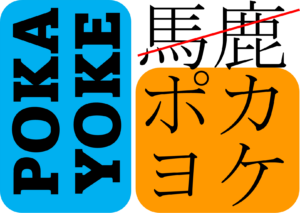 Poka yoke is Japanese for mistake proofing. It is a way to reduce errors and mistakes by designing the product so that it cannot be assembled or used incorrectly. I find this extremely useful, not only in manufacturing but also in many instances in daily life where poka yoke prevents me from making mistakes. In this post, I would like to talk about poka yoke, and the two fundamentally different directions poka yoke can take.
Poka yoke is Japanese for mistake proofing. It is a way to reduce errors and mistakes by designing the product so that it cannot be assembled or used incorrectly. I find this extremely useful, not only in manufacturing but also in many instances in daily life where poka yoke prevents me from making mistakes. In this post, I would like to talk about poka yoke, and the two fundamentally different directions poka yoke can take.
Quality
Posts related to quality: How to measure it, how to improve it, etc.
The Toyota KPI Dashboard—Quality
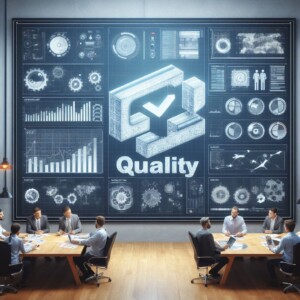 In this third post of my series on the Toyota dashboard we will be looking in more detail at quality. The quality of Japanese car makers in general and Toyota in particular is quite a bit better than the rest of the world’s. After safety, quality is the second-most-important issue at Toyota, definitely before productivity and cost. They do put in quite some effort for tracking quality… and then put in even more effort to fix these issues! Let’s have a look:
In this third post of my series on the Toyota dashboard we will be looking in more detail at quality. The quality of Japanese car makers in general and Toyota in particular is quite a bit better than the rest of the world’s. After safety, quality is the second-most-important issue at Toyota, definitely before productivity and cost. They do put in quite some effort for tracking quality… and then put in even more effort to fix these issues! Let’s have a look:
Ramp-Up and Ramp-Down of Production
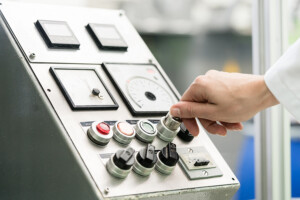 In my last post I looked at the preparations for a proper ramp-up or start of a machine or process. This post is the second part where you actually press the button and start the machine. I will also discuss the ramp-down procedures, as well as a SMED-like approach to improve the ramp down and up again process.
In my last post I looked at the preparations for a proper ramp-up or start of a machine or process. This post is the second part where you actually press the button and start the machine. I will also discuss the ramp-down procedures, as well as a SMED-like approach to improve the ramp down and up again process.
What’s Buzzing?—Vibration Sensors in Industry
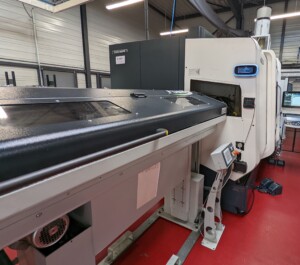 During our Van of Nerds tour in France in 2022, we came across a few vibration sensors. In manufacturing, vibration sensors are frequently used to measure machine- or tool-related data. Some of these sensors were variations of what I have seen before, but the one for measuring machine performance was stunningly good and something I have not seen before. Hence, in this blog post I would like to share my findings on vibration sensors in industry.
During our Van of Nerds tour in France in 2022, we came across a few vibration sensors. In manufacturing, vibration sensors are frequently used to measure machine- or tool-related data. Some of these sensors were variations of what I have seen before, but the one for measuring machine performance was stunningly good and something I have not seen before. Hence, in this blog post I would like to share my findings on vibration sensors in industry.
The Pillars of TPM – Quality, Training, Administration, and Safety
 This post continues the series on the pillars of Total Productive Maintenance (TPM). Here we look at the last four pillars: quality, training, administrative, and safety. However, I find those pillars weaker than the first four. While the topics are important, in my view they should not be separate pillars. I think these topics are either better placed elsewhere (administrative) or should be integral part of all the other pillars (quality, training, and safety). Hence, I believe this is a weaker part of the TPM framework, and I won’t go into as much details as the previous pillars. In any case, let’s have a look. But feel free to disagree! I am looking forward to your comments, as I will surely learn something from them.
This post continues the series on the pillars of Total Productive Maintenance (TPM). Here we look at the last four pillars: quality, training, administrative, and safety. However, I find those pillars weaker than the first four. While the topics are important, in my view they should not be separate pillars. I think these topics are either better placed elsewhere (administrative) or should be integral part of all the other pillars (quality, training, and safety). Hence, I believe this is a weaker part of the TPM framework, and I won’t go into as much details as the previous pillars. In any case, let’s have a look. But feel free to disagree! I am looking forward to your comments, as I will surely learn something from them.
115 Years after the Birth of Joseph Juran
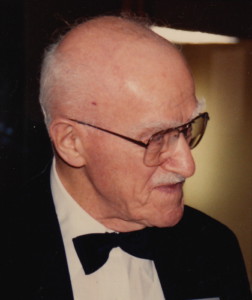 On Christmas Eve 115 years ago, Joseph Moses Juran (December 24, 1904 – February 28, 2008) was born. He was a highly respected and very influential quality guru. His work not only helped the United States, but also changed Japan, possibly even more than that of his better-known colleague Edwards Deming. Time to look back on his life’s impact on the world.
On Christmas Eve 115 years ago, Joseph Moses Juran (December 24, 1904 – February 28, 2008) was born. He was a highly respected and very influential quality guru. His work not only helped the United States, but also changed Japan, possibly even more than that of his better-known colleague Edwards Deming. Time to look back on his life’s impact on the world.
The Phases of a Changeover
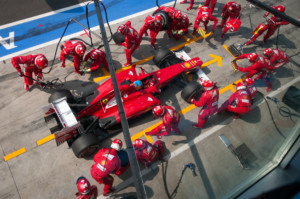
A changeover is changing the set-up of a process from one product to the next. Reducing changeover times is a common and popular way to decrease inventory or to increase available work time (see SMED). Ideally, the changeover time should be zero, allowing true one-piece flow. In reality, however, it is often not zero. This post looks in more detail at the different phases of a changeover to help you understand the process better and to reduce your changeover times.
Organize Your Production Sequence – 1: Project Shop
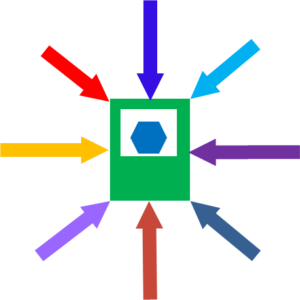 There are different ways to organize your shop floor. You surely know the flow shop and the job shop. There is also a project shop (with many variants of names). While the flow shop is in many cases the ultimate goal, each shop has advantages and disadvantages. Let’s look at them in more detail, starting with the project shop.
There are different ways to organize your shop floor. You surely know the flow shop and the job shop. There is also a project shop (with many variants of names). While the flow shop is in many cases the ultimate goal, each shop has advantages and disadvantages. Let’s look at them in more detail, starting with the project shop.
